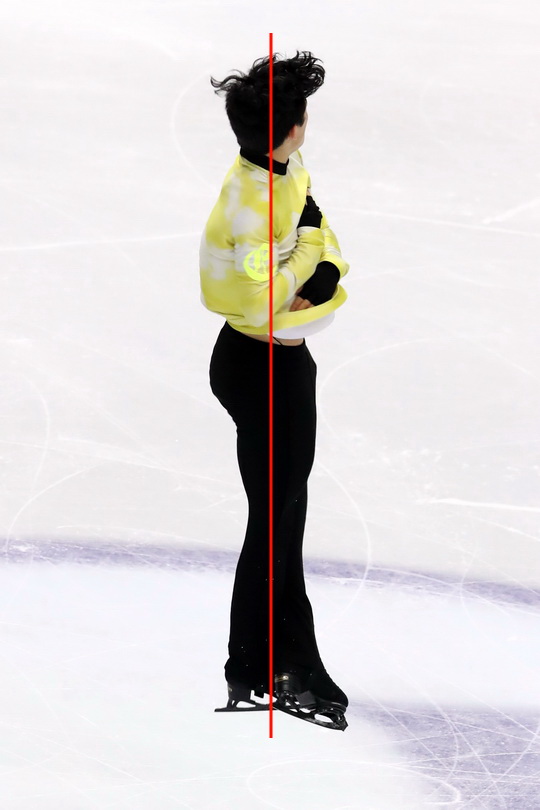
Air position with a straight rotation axis.
Angles as perceived by an observer are not what they appear.
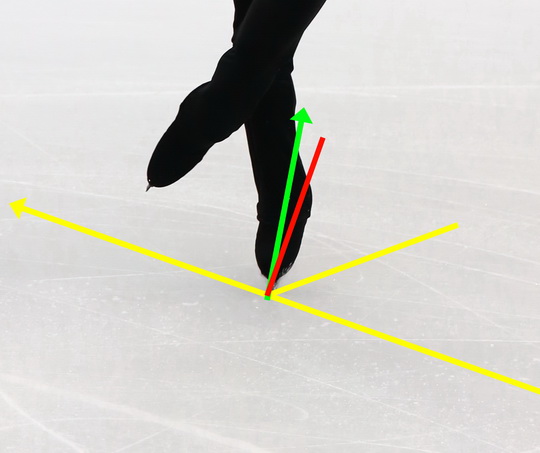
This detail of the jump landing is taken from the last image at
bottom right. It gives the appearance of a jump perilously
close to being under-rotated.
The red line has been added perpendicular to the line of flight.
A landing with the foot on the red line, or farther clockwise, would
appear to meet the definition of under-rotated; i.e., perpendicular
to the line of flight or past that, and thus missing
one-quarter rotation or more.
Angles, however, are distorted by projection effects from the
viewing angle of the observer. In reality, any foot position
up to the short yellow line would be less than one-quarter rotation
short of the line of flight for this jump.
Downgrade calls with the blade along the line of sight are
unambiguous for all viewing angles, but under-rotation calls cannot
be accurately made without taking into account the line of sight
of the viewer.
Projection effects are worse the closer the viewer is to ice
level and also depends on the orientation of the line of flight
relative to the line of sight of the observer. Thus, the
correction for projection effects is specific to the geometry of each jump
and the location of the observer.
Current replay systems do not take into account projection effects
when used to determine under-rotation calls in competition. An
additional complication is that the viewing angle of the Technical
panel in real-time is significantly different from the viewing angle
of the replay camera.
|
(24 February 2020) The ISU is currently willing to
give full credit to quad attempts no matter how little rotation they really
have, as long as they give the illusion of a quad and are not
under-rotated on the landing. So much so, you might come to
think fully rotated quads just can't be done.
But that isn't the case.
We present here as an example, a quad Salchow
executed by Yuzuru Hanyu in the Short Program of the 2019 Grand Prix
Final that illustrates the geometry of a fully rotated quad. It doesn't get much better than this when it comes to
complete rotations. This jump was 0.76 sec in the air, and
ever so slightly under 3
3/4 rotations in the air.
(1)
|

|
The skater is on a clean back inside edge at the takeoff.
The green arrow shows the line of flight the jump would have
had if the skater had jumped exactly vertically at the
takeoff - tangent to the takeoff edge at the moment of
leaving the ice. The yellow arrow shows the actual
line of flight of the jump in the air.
Notice how open the arms and free leg are at takeoff.
Skaters who pre-rotate this jump (and other quads) are already significantly
pulled in at this point, often turning forward on the
skating leg before they are about to leave the ice.
|
| |
|
 |
There is no turn, scrape or pivot off the skating foot,
as seen in the close-up of the entry edge.
The green arc is drawn just below the entry edge of the
jump. The green arrow shows the line of flight the
jump would have had if the skater had jumped exactly
vertically at the takeoff. (The broad scrape from
center of the image to upper right corner is not part of
this jump.)
The yellow arrow shows the
actual line of flight in the air. The short yellow extension
to the right of the yellow arrow is the perpendicular to the
line of flight on the ice as projected by the viewing angle
of the camera. The angle between the green and yellow
arrows is a bit more than one-eighth rotation.
|
| |
|
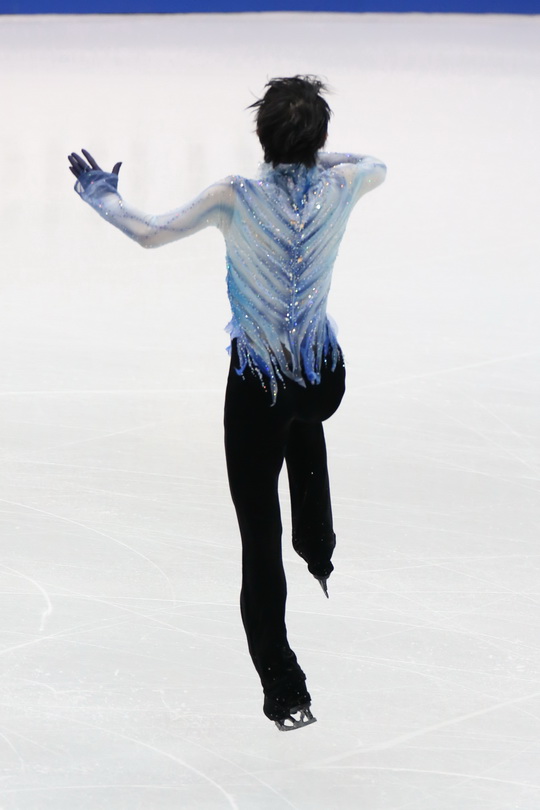 |
The skater is well into the air in the first quarter
rotation.
The skater is still not fully pulled in.
|
| |
|
| |
|
| |
|
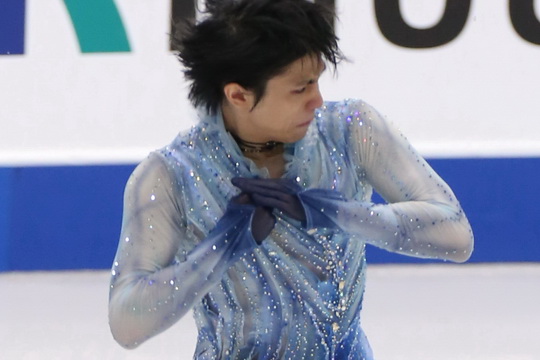 |
Note the position of the hands when pulled in used by
the skater, with the right hand in a fist pushed into the
open palm of the left hand. This position very
slightly increases the moment of inertia compared to both
hands with flat palms against the torso. This
technique is used by a small number of skaters.
|
|
|
|
|
The air position of the skater departs from ideal in
several respects: the body of the skater is somewhat bent along
the long axis at the waist and knees; the legs are not
straight and in contact with each other; the arms are not
tight at the side, the hands are not flat against the torso.
And yet the skater had no problem fully rotating the jump.
Compare the bent rotation axis of this position to the
straight rotation axis for Nathan Chen at top left.
|
| |
|
|
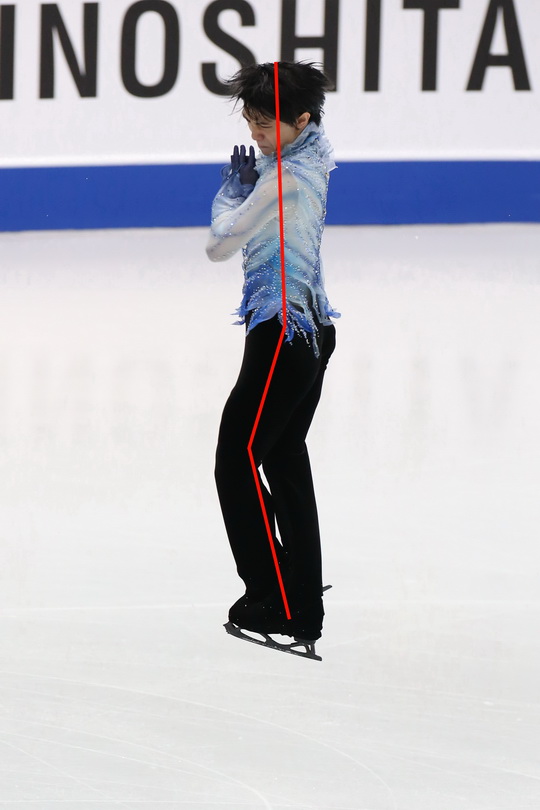
Bent rotation axis slows the rotation.
|

Other factors that slow the rotation.
|
| |
|
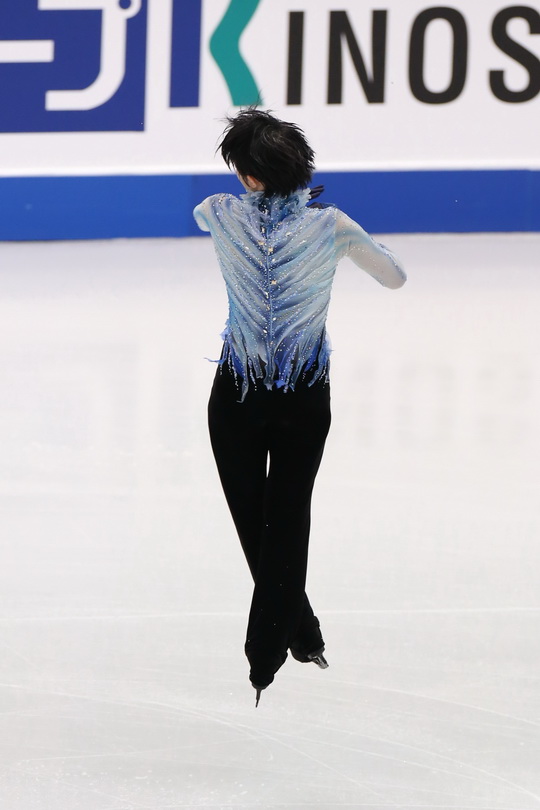 |
The skater remains pulled in until nearly the instant of
contact with the ice (no more than the last 80 msec in the
air). This jump was landed with a higher rotation rate
than most skaters are capable of controlling, about four
rotations per second.
The average rotation rate was 4.9 rotations per second
with a peak of about 6.1 rotations per second, making the
air rotation efficiency about 80%.
(2, 3)
The relatively narrow shoulders and hips of the skater,
compared to other competitors,
gives this skater an advantage by allowing a potentially
lower moment of inertia and higher rotation rate than
typical.
|
| |
|
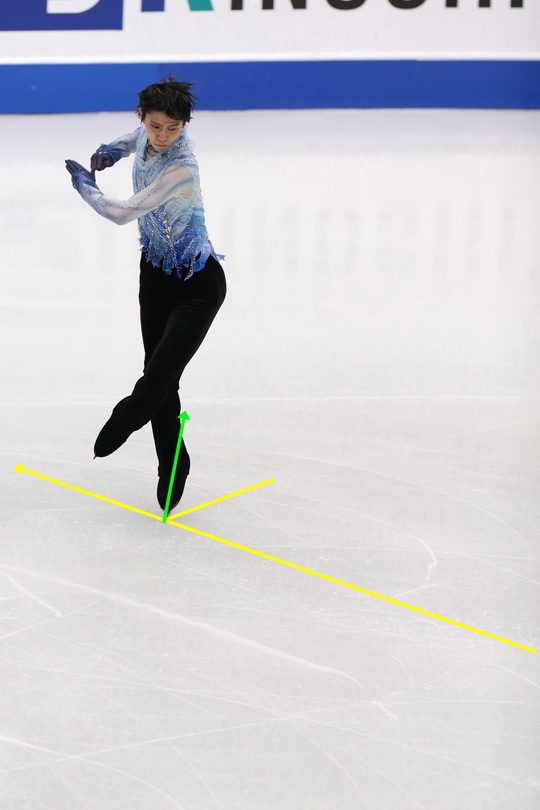 |
The skater lands cleanly on the toe picks and exits the
jump fairly smoothly. The landing blade makes an angle
of nearly one-eighth rotation with respect to
the line of flight at the landing.
The yellow arrow shows the
actual line of flight in the air, extended past the point of
landing. The short yellow extension
to the right of the yellow arrow is the perpendicular to the
line of flight on the ice as projected by the viewing angle
of the camera. The green arrow is the landing
orientation of the blade. The angle between the green and yellow
arrows is a bit more than one-eighth rotation.
|
Fully rotated quads, where we define fully rotated
to be near one-quarter rotation short of integer rotation, are
not only achievable in theory, they are actually being executed by
some of the best jumpers.
Due
to the difficulty of a true quad compared to a triple, the high point values for quads in
the Scale of Values compared to triples is warranted for jumps that are complete.
Skaters who take shortcuts through pre-rotation, however, should not be rewarded with the same
base points for doing a less difficult attempt, nonetheless called
as a complete quad, that might only have 3
1/4 rotations in the air - though
unfairly they currently
are.
Notes:
(1) Fully rotated Sachows do not have
an integer number of rotations in the air. Due to the motion
of throwing the free leg to the side across the skating leg during
the takeoff, as the skater remains on a back inside edge, the jump
takes off somewhat to the side instead of directly backwards.
Fully rotated Salchows are near one-quarter rotation
short of integer rotations, generally about one-eighth short each on
the takeoff and landing, as was the case in this example.
(2) We define the air rotation
efficiency to be the average rotation rate from takeoff to landing
divided by the maximum rotation rate. Values of 0.8 to 0.9 are
typical for skaters.
(3) If the skater were to refine the
air position, a peak rotation rate of 6.5 rotations per second is
within grasp. Food for thought: 6.5 rotations per second + 85%
air rotation efficiency + 0.78 seconds air time + an acceptable
one-quarter pre-rotation = quad Axel.
Text and all photos Copyright 2020 by George S. Rossano
|

